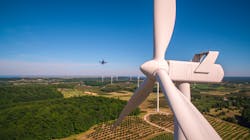The wind industry accounts for 6% of the electricity generation in the United States, but wind farms are still very expensive to operate, limiting the potential scale and adoption as a renewable energy source. One expensive component to maintain is the blades. Studies show that blade damage accounts for approximately 23% of the annual costs. Current operations and maintenance approaches to this type of damage (both onshore and offshore) are generally focused on “reactive” or “corrective” practices, which often results in high costs for repairs and significant losses in revenue.
Drones have become a viable means of collecting data on wind turbine blades. Enterprise drones make it faster, easier, and more efficient, which allows for savings in the earlier stages of inspection, before the repair and planning stage. Additionally, drone inspections provide a safer and less resource-heavy alternative to rope inspections, ground-based camera inspections, and other traditional types of monitoring programs.
Automated Versus Manual Drone Inspections: Are they that Different?
There are three basic types of drone inspection: manual, semi-automated, and automated. Manual inspections are simply those that require pilot or technician to handle the inspection from the ground, manually steering and manipulating the drone so as to capture images of all four sides of all three blades. Semi-automated is usually a combination of manipulating the blades to a set position and then setting manual waypoints that the drone follows. In this scenario, the drone cannot “see” the blades and will therefore not avoid them if the waypoint crosses its path. It is also limited to inspecting a single blade at a time.
Automated inspections, which are less commercially available due to the sophistication of the technology and artificial intelligence necessary to achieve them, do not rely on a pilot to guide the inspection. The drone is able to perceive the blades and develop its own flight path to capture all the necessary data without running into the blades. Automation provides a repeatable, highly accurate inspection that produces data that has advantages to the data produced by a manual inspection, including:
- Removal of human error out of each inspection, guaranteeing a complete and thorough inspection of every blade, every time;
- Repeatable results — drones using automation and AI produce highly measurable and comparable results, providing numerous advantages including things like comparing identical year-over-year images of the same damage, in the precisely same place;
- Reliability of the technology removes error. Severe damage or damage that is rapidly progressing is discovered before it requires significant downtime to repair. Planning and proactive maintenance strategies can then be employed.
Data for Decision Making and Preventative Maintenance
Good data is required for the technologies of tomorrow, such as machine learning and artificial intelligence, which require a foundation of high-quality, complete data to work. Two years ago, a drone inspection was the beginning and end of the story. Often, after a manual drone inspection (the only type available), the overwhelming number of images collected were passed off to a customer in a format that confusing and cumbersome. Excel files or a mass of pdfs were produced, simply contributing to the overall problem that so many industries face: too much data.
Fast forward two years and the robotics companies that are still afloat and thriving in a commercial wind energy environment have been able to make use of what is, by now, millions of images of blades. For automated drone inspection companies, the data produced has begun to reveal a staggering amount of insight and actionable data.
Again, because automated inspections are repeatable, measurable and reliable, the data - particularly the data collected on the same turbines over time - grows more powerful with every inspection. Multiply that power when one couples a predictive analytics software system with an automated data collection capability.
Data that is parsed, organized, analyzed, and categorized can be transformed into decisions. Major wind energy providers have seen tremendous ROI on well-collected and thoroughly analyzed wind turbine blade inspection data.
A Practical Example
SkySpecs recently partnered with a global leader in the renewable energy sector. Historically, the company approached blade inspections using ground-based cameras or by waiting until the blade damage was so severe it had to be repaired immediately. Neither method was working well, but they were skeptical about the benefits of less traditional methods of data collection and analysis. The customer projected that one percent of their 100 to-be-inspected turbines would reveal damage.
Using automated drone data collection, SkySpecs inspected 100 turbines in five days. Data was uploaded to their analytics software hub and it revealed the following:
- 17% of the turbine blades were identified as having category four or five damage (on a scale of one–five, with five being the most critical).
- A trailing edge crack in the exact same location on just over 20% of the blades inspected
These findings enabled the owner to claim exponentially more on their collective end-of-warranty inspections that they would otherwise have been able to, due to precise data collection and thorough categorization and analysis that they were able to submit to their insurance provider.
Disparate data collection methods, a lack of system that makes sense of it, and outdated methods of dealing with inspections and the enormous bulk of data they produce have led to a critical need for a “single source of truth.” As more companies embark on the quest for “big data” solutions, it’s essential that they look for a complete solution — one that results in business decisions that benefit the entire organization and create a more unified and informed approach to future sustainability.
About the Author
Gordon Feller
Europe Insights Editor
Gordon Feller has spent the past 40 years working to create a sustainable energy future. Among his many roles, he served as an Obama appointee on a select U.S. Federal Commission, established by the U.S. Congress to focus on recommending actions to address the future of utilities, the grid, EVs and storage.
